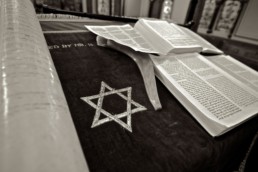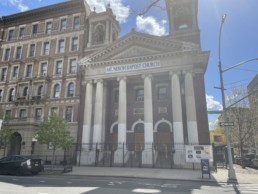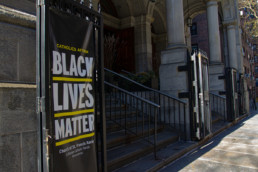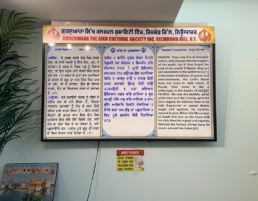Learning Forgiveness in the Age of Cancel Culture
As the seventh Psalm wraps up, representing the seventh day of the week, the congregation at Stephen Wise Free Synagogue on 30 West 68th Street sits down. Rabbi Ammiel Hirsch approaches the front of the Bimah, where the Torah is read, to begin his weekly Friday night sermon.
Instead of focusing on a piece of scripture, Hirsch begins with a story from pop culture.
“I never met Whoopi Goldberg,” he began. “And I don’t watch The View.”
A couple members of the congregation reacted with nervous laughter at the mention of Goldberg in light of recent events. Hirsch waited a couple beats before continuing his speech. Earlier in the week, Whoopi Goldberg was suspended for two weeks from her daily talk show, The View, for saying that the Holocaust was “not about race” on air.
“Whoopi Goldberg said some truly offensive and ignorant things, but she apologized immediately and sincerely,” Hirsch said. “Repentance, forgiveness and atonement are central concepts in religion.”
As Hirsch spoke, his congregation nodded their heads slowly in agreement. They too believed that forgiveness is a crucial part of their worship and faith.
“Americans nowadays seem incapable of accepting apologies,” Hirsch continued.
For both the teacher and his students, the message was about how to face “cancel culture,” or the fear of societal backlash over a genuine mistake, as an observant Jew. Hirsch’s sermon used Goldberg’s offensive comment as an opportunity to talk about forgiveness and trust in God. Both of these tenets are core to Judaism, according to Hirsch.
Hirsch explained to his congregation that human nature resists wanting to own mistakes and apologize for them, emphasizing that “it is hard to do.”
Many quizzical looks filled the faces of Hirsch’s listeners then. If forgiveness was essential to their faith, but it was difficult to do, what were they supposed to do? Was there a way they could combat this human urge with their religion?
Hirsch had an answer: The High Holy Days.
According to Hirsch, the High Holy Days, also known as Rosh Hashanah and Yom Kippur, are meant for repentance and forgiveness. In Hebrew, Rosh Hashanah means, “Beginning of the Year,” and Yom Kippur means “Day of Atonement.” Hirsch’s sermon focused on both the literal and spiritual meanings of each by explaining how to react and forgive Goldberg for her comment. Hirsch said he believes she should be forgiven because she genuinely apologized and atoned for what she said.
“Judaism is so insistent on contrition and forgiveness that our holiest season of the year, our highest of High Holy Days, is devoted to urging people to repent and forgive,” Hirsch said. “The reason we make such a big deal about it — ten full days of almost nonstop prayer and lamentation, beating our chests in sorrow — is that it is hard to do.”
Hirsch was teaching his worshippers to forgive Goldberg not because it is the easy thing to do, but because from his view, forgiveness is the right thing to do. The reason why forgiveness and acceptance are so important to human relationships is because without them, society will end up “nasty, brutish, violent and tribal,” Hirsch said.
Instead of using a reading or lesson from the Torah, which is the law of God as revealed to Moses and recorded in Hebrew, Hirsch used a news story to teach the Jewish values of forgiveness and atonement.
Cantor Daniel Singer explained that the Friday sermon is different from the Saturday sermon each week during Shabbat services. Singer said that the Rabbi, Hirsch, has never given the same sermon twice. At Stephen Wise Free Synagogue, the Torah is only read on Saturday and holidays, according to Singer.
Most Saturdays, the sermon or speech is given by a Bat or Bar Mitzvah, instead of Hirsch, after their Torah reading, Singer said. According to Singer, Hirsch draws from all areas of life for his weekly sermons, but enjoys preaching about Jewish heritage, history and social justice issues the most.
In Harlem, Sunday School Students Contemplate Justice
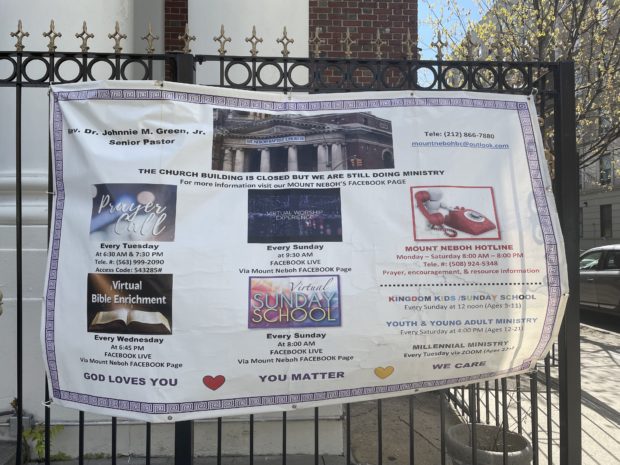
The first Sunday in March was the end of an era in the life of Mount Neboh Baptist Church in Harlem. It was the last Sunday that the church would hold virtual services, an accommodation it had offered since the beginning of the COVID-19 pandemic two years ago.
Since March 2020, the parish, at 1883 Adam Clayton Powell Boulevard, had only been open a few hours a day from Tuesdays to Fridays.
When I tuned in for the final virtual lessons at 8 a.m. on Sunday, I watched people pop into the Zoom and Facebook Live call one by one, smiling at each other and dropping familiar good morning messages in the chat.
But instead of celebrating the end of an era or speculating what it would be like to gather in person once again, the online conversation was all about justice.
“Does God pervert justice?” asked the Reverend Gerforne Johnson.
Blank stares from behind screens left Johnson bewildered.
“Did I go on mute?” she asked.
I didn’t know enough about God to answer her question. But as I learned later in the virtual Sunday service, even Christians aren’t meant to always know God’s will.
The Sunday school, part of the church’s Black History Month teaching series, would be about the misunderstanding of God’s justice, taught through the story of Bildad and Job from Job 2:11.
“Can someone highlight what is one of the biggest injustices we face as people of color?” asked Minister Maya Clarke for the adults of Bible Study group three’s icebreaker prompt.
Echoes of “voting rights” “job discrimination” and “racism” flooded the unmuted crowd of fifteen.
From overlapping voices emerged the answer Clarke was looking for: police brutality.
“Too many innocent women and men of color are being killed or assaulted at the hands of police officers,” she said. Her use of the present tense made me realize this lesson wouldn’t only be about biblical history. Black churches in America have been forced to reckon with external social and political injustices since their inception.
Before sympathy or condolences are offered to those killed by law enforcement, Clarke continues, the criminal past of Black victims is often used to purport an explanation for why they landed in the position they did. In other words, Black victims are blamed far more than White victims, as if their past transgressions justified their deaths.
“Do you ever find yourself victim-blaming?”
Nobody wanted to answer this one, perhaps afraid to show that they had ever acted in judgment.
“With all things, God's justice is always fair despite what it might look like.”
Bildad was a Shuhite, from the nomadic tribe of southern Palestine. He had been placed by God in Job’s life after Job had lost his children because of their sins– a test of Job’s faith. Bildad told Job that all of the negative events in his life were a punishment for his sins, on the premise that the righteous would never suffer.
But Bildad was wrong, Johnson said. He assumed he knew what God was thinking.
“Do you blame God for things that you don’t understand?”
A woman piped up from the boxed congregation. “Yes, I blamed God when my Grandma passed, because I didn’t understand why He would do this to the only person I knew who lived exactly by His word.”
“Only God knows why bad things happen to good people,” replied Johnson. I wondered if the woman was satisfied with her answer.
Sister Shirley Monroe seemed as though she had been pondering a question during the entire Bible Study, and was itching to pose it to the group.
“I just wanted to know why people say it was God’s will if someone gets killed in the streets,” she said. “Was that really God doing that?”
A tonal shift among the crowd indicated that questioning God’s motives behind human suffering was a difficult and heavy topic to approach.
The senior pastor, the Rev. Dr. Johnnie M. Green Jr. spoke up from a moving vehicle to answer Monroe’s query.
“God doesn’t order a hit on somebody’s life,” he said. “But a person who dies from street violence may often be reaping the seeds they’ve sown.”
Wasn’t this victim-blaming? I was unsure how the pastor had understood the lesson in such a different way than I had, but he doubled down in his next statement.
“God allows certain things to happen and we have to accept it as the grand scheme of things. Sometimes people bring it on themselves.”
The pastor’s words felt like a sharp detour from today’s message. I looked at the faces of the churchgoers to see if anyone felt differently about the question, but they remained expressionless, maybe to say that the head pastor had the final call.
I wish I knew how God put His plans in action. I wish I knew why bad things happen to good people. Was everyone else truly okay with not knowing? ![]()
Violence on the streets of New York has continuously caused suffering in the Black community, and that suffering has led to a collective grief. But in that grief, for believers to accept their fate as players in God’s long game, is something that fascinates me about faith. Deep down, they must trust that everything happens for a reason they might never understand. I realized the theme of today’s lesson was about control– how Christians must grapple with the things out of their control, and how God’s omnipotent control is one of Christianity’s great mysteries.
The Meaning of Purim, the Jewish Identity
On Saturday evening, the Orthodox Jewish community of the Congregation Kehilath Jeshurun gathers in the Synagogue to close Shabbat with a Havdalah blessing.
Halfway through the service, one rabbi gives a pre-printed source sheet to each synagogue member. Rachel Kraus leaves her seat in the women's section and steps to the front of the synagogue audience. She cautiously removes her face mask to make her voice echo throughout the room as she adjusts her long dress and begins the sermon.
She encourages the faithful to use the 30 days between now and Purim to reflect on the nuances of the holiday. Purim is the 15th day of Adar and is a holiday for Jews to be happy. According to the book of Esther, in the 5th century BCE, the Jews survived after the Persian rulers ordered to kill them, and Purim was the day when they celebrated their salvation.
Kraus vigorously explains to the congregation her interpretation of Purim and what this holiday indicates about Jewish identity. To do so, she uses 13 texts that are listed on the source sheet.
"Just as with the beginning of Av, rejoicings are curtailed, so with the beginning of Adar rejoicings are increased" (Talmud Masechet Ta'anit 29a). This is the first source in Kraus' collection. She explains to the congregation that Purim contrasts with the month of Av, which represents disruption and is seen as the lowest and saddest time in Judaism. Both temples in Jerusalem were destroyed during this month, and other calamities struck the Jews.
On the contrary, Purim is a happy and festive day. However, Kraus mentions that there are phrases and passages in the biblical and historical Jewish texts where this day does not seem so happy. The question, then, is whether Purim is a joyful day or not. Kraus answers that it is both, and it is a moment when we need to take a deep look inside ourselves.
According to Kraus, one must use the month of Av as a counterpoint to make the best of the day of Purim and be happy. The believer is called upon to understand whether they are giving attention to the right things or taking the wrong path. She says that this idea also defines Jewish identity as a community that always looks to its past to know how to face the future; "These days of Purim shall never be repealed among the Jews, and the memory of them shall never cease from their descendants." (Esther 9:28) Jews must always have their entire journey in mind. "(Purim) Help us go in the right direction," says Kraus.
The congregation listens in respectful silence to Kraus' words. Everyone is seated with their gazes turned toward her. This is one of the only moments when no one speaks or prays simultaneously, as it sometimes happens during the intonation of the hymns.
Even the children who usually do not actively follow the evening services are now sitting and listening to the young woman's words in front of the congregation, who encourage the faithful to reflect. There are about 50 men and a dozen women in the synagogue, and they all follow closely, nodding when they recognize themselves in Klaus' explanations of the Talmud.
Kraus ends her sermon; Purim is not just a happy holiday. It is a day when the faithful reflect on their past to make the right choices in the future. "When we forget where we come, we forget where we go," she recalls.
The congregation thanks Kraus by saying "Shabbat Shalom," and she returns to the midst of the women, who greet her with congratulations.
The faithful pass around the Havdalah spice box, and each member of the congregation sniffs it to give themselves energies for the next week until the following Shabbat. The rabbi blows out the candles. The service is over, and with it, the Shabbat.
Social Justice Meets the Mass
Counting hymnal mentions, the word ‘mercy’ was intoned 37 times during the 9 a.m. service on a recent Sunday at St. Francis Xavier, a Roman Catholic church in the Jesuit tradition, snugly situated in the Flatiron District neighborhood of Manhattan.
The Rev. Kenneth Boller made the concept of mercy progressively applicable throughout the service. After an hour of traditional Catholic liturgy, he led the congregation in a more contemporary affirmation.
“Do you affirm that white privilege is unfair and harmful to those who have it and to those who do not? Do you affirm that white privilege and the culture of white supremacy must be dismantled where it is present? Do you support racial equity justice and liberation for every person? Do you affirm the inherent worth and dignity of every person?"
The congregation of 100 people answered “yes” to each of these questions with enthusiasm. In so doing, the members of St. Francis Xavier have been committing themselves to these social justice principles every week since the affirmation was first introduced on Aug. 30, 2020.
Since then, some conservative commentators have attacked gone on the attack. A few agitated Twitter users have accused Boller of turning his service into “a left-wing political rally.” Videos of the service have gone viral. The conservative entertainment company Blaze Media, which reaches 165 million people every month, published an article calling the statements “revolting.” Trudging past online criticism, Boller’s affirmations prevailed.
Doing no harm is a form of activism, Boller said. Led by the Holy Spirit, Catholics ought to be able to avoid harming all people via radical mercy.
The Church of St. Francis Xavier is unafraid to live in the tension between tradition and progress. Comfortable with anachronism, this house of worship is a place where Boller, the church’s pastor standing at a pulpit built in 1850, will readily grapple with issues like cyberbullying and misinformation on social media. This conflict echoes the tensions within American Catholicism today. The religious are taking sides between loyalty to a centuries-old establishment and dissent. But this Jesuit congregation rejects the binary altogether - in the name of mercy.
In his Sunday sermon, Boller took on everyone from the Biblical David to the contemporary leaders of the Roman Catholic Church.
The scriptural reference in the homily, or the commentary lesson that follows worship, was 1 Samuel 26. In this part of the Bible, David spared his sleeping enemy, Saul, who was the first king of Israel with a militaristic streak. David, who will (spoiler alert) eventually replace Saul as Israel’s leader, justified his merciful choice to not stab his adversary when he said, “Do not destroy Saul, for who can put out his hand against the Lord's anointed people and be guiltless.” David believed God valued some lives more than others; God prioritized the blessed nation of Israel above those of any other descent or station Boller explained.
Boller went on to commend David’s choice to do no harm but criticized David’s reasoning for doing so. Peaceful action without equitable intention is not good enough, the Queens-native pastor argued. The key to not harming others is knowing God loves all people equally, he added, this democratization of access to salvation hinges on living out the Gospel. Do not be like David, Boller said to his audience.
Deliberately not causing harm is a high Catholic standard that extends politically, interpersonally, virtually, physically, racially, emotionally and sexually. At that last point, Boller waved his hands around to referentially gesture the credible claims of abuse plaguing Catholic leadership. Thereafter, Boller brought up the famous creed of bioethics and a variation of the Hippocratic Oath, “First, do no harm,” which Boller said should be applied by the scientific and religious alike. Catholics are not appointed to punish the people who wrong them. Quite the opposite is true, Boller concluded. Much like the medical field, Boller said, the Catholic tradition possesses a life-giving tool of mercy, which should lead worshippers to accomplish good in the world. The Catholic ideals entail turning the other cheek, (Matthew 5:39).
“Differences of power and resources just give some people more responsibility of helping the common good,” Boller said.
Sikhs in Queens Pay Tribute to Prominent Figures Old and New
On Sunday at The Sikh Cultural Society gurdwara at 118th Street in South Richmond Hill, Queens, a crowd of Sikh worshippers slip off their shoes and make their way to the Darbar Sahib for the day’s service. The women, many displaying their gold-adorned kurti tops, sit to the left of the hall. Men sit scattered on the burgundy carpet to the right of the room in rows. Their vibrant turbans in orange, turquoise, yellow and white dot half of the massive hall.
Though each worshiper performs daily readings on their own, they gather en masse at the gurdwara to learn from the Granthi’s interpretation of the Guru Granth Sahib. Granthis serve as guardians over the Sikh holy book, Guru Granth Sahib. Before the devoted hear the scripture, they see it. The seafoam green walls in the main hall display the day’s scripture in the Punjabi Gurmukhi script. Beside it is the English translation. This hukam, as it is called, is chosen at random and serves as the day’s guiding principle. Later on in the service, the gurus will recite and decipher the meaning.
There is a celebration of both life and death occurring on this Sunday. The usual crowd looms larger than previous ones. The seventh guru, Har Rai Sahib Ji, has a birthday. For Sikhs, this guru who died in the 17th century is revered for his military leadership. Across the hall from the hukam are images plastered in remembrance of Deep Sidhu, a famous Indian actor, lawyer and activist, who died the same week. Sidhu had been vocal in the recent Indian farmers’ protest about his support for the working class farmers against the Indian government. He is also a hero to those of Sikh faith.
The afternoon prayers begin with a memorial service to the late actor and activist. A man behind a podium makes a booming speech in Punjabi into a microphone. As he stands behind the podium addressing the room, he is being live-streamed online. He informs the youth in the room about Sidhu’s efforts, encouraging them to advocate for their beliefs like Sidhu. This message fell in line with a Sikh core tenet and practice, which is service to humanity and political activism.
The service transitions to singing from the youth. Six girls and two boys sing kirtan, songs of praise to God. Two girls in front played the harmoniums while off to the corner, one boy knocked the tabla drums to a beat. The song is chosen at random days before but prepared and sung according to the mood. Before harmoniums were introduced by the British to India, string instruments were played by the Sikh women for this practice. The harmoniums are easier to play but the string instruments require a skilled craft to turn out musical notes.
The worshipers sing along to the hymns but most make the descent to the basement’s kitchen for langar. When they return, the reading from Guru Granth Sahib is underway. In the prayer room, the elephantine book sits higher than everyone else. As a holy text, it must always be elevated. The Granthi sits behind it; his black turban peeping from the backdrop of a gold khanda, the Sikh symbol of swords. People stand with their hands clasped listening to the Granthi recite from the holy book in Punjabi. Once allowed to sit, they retreat to the carpet—legs crossed, listening intently.
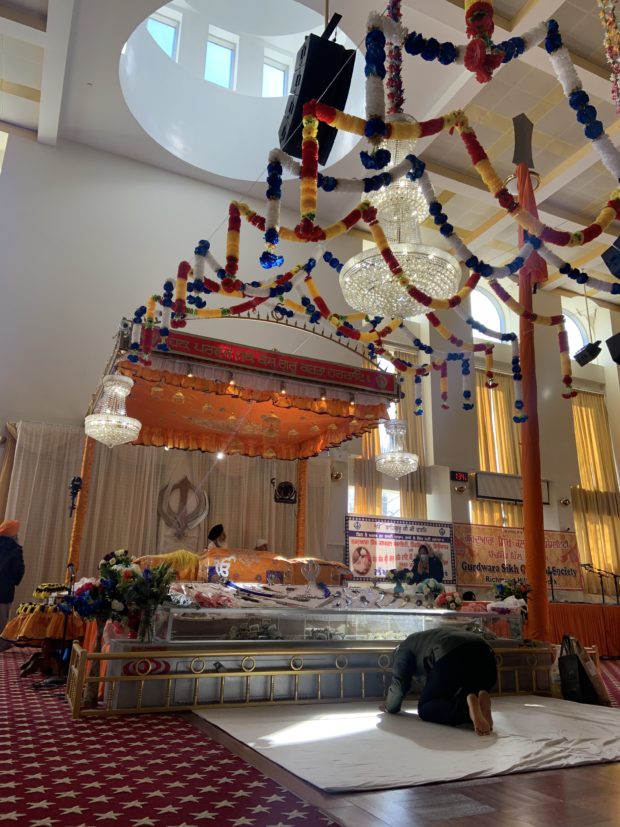 The Granthi is joined by a second Granthi who serves as the translator of the sacred text. In Punjabi, he explains what was just read from the scripture. All the while, the guardian of the holy text steadily waves a large canary yellow scepter, known as a chaur sahib, around the book. The chaur sahib is a ceremonial ornament that on one end is bejeweled and on the other, extended with animal hair that bears a strong resemblance to a horse’s tail.
The Granthi is joined by a second Granthi who serves as the translator of the sacred text. In Punjabi, he explains what was just read from the scripture. All the while, the guardian of the holy text steadily waves a large canary yellow scepter, known as a chaur sahib, around the book. The chaur sahib is a ceremonial ornament that on one end is bejeweled and on the other, extended with animal hair that bears a strong resemblance to a horse’s tail.
Faint whispers can be heard throughout the hall as people recite the scripture to themselves. Some younger Sikhs follow the words on apps on their phone. Then they all join in song. Some vocals pitch higher in the crowd and they sing out loud alone, as the music moves them.
Afterwards, people line up on the long wood panel corridor and prepare to bow and make optional donations in front of the shrine where the Granthi sat protecting the holy book. Once the initial bowing is over, some travel around the holy shrine area where they make additional bows and prayers around the square. A final prayer is said, internally or through a pale voice, at a pole dressed with the bright orange nishan sahib flag, where hands make a delicate touch before parting from the area.
When the service is over, the Guru Granth Sahib is draped with a vivid orange cloth beaded in Indian designs, known as the rumala, awaiting its removal to the upper floor of the gurdwara, where it will stay enclosed in a locked room until morning comes again.

